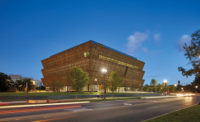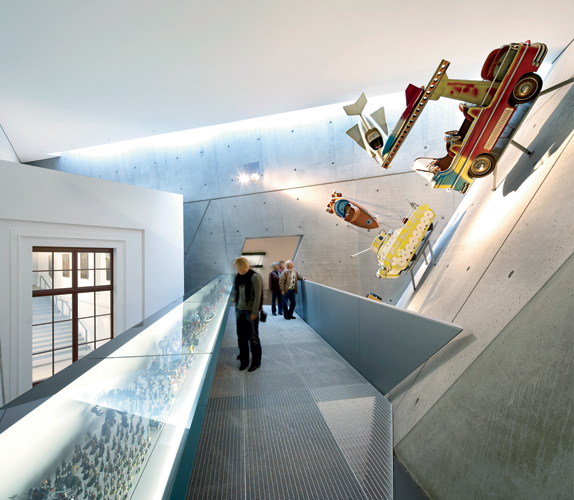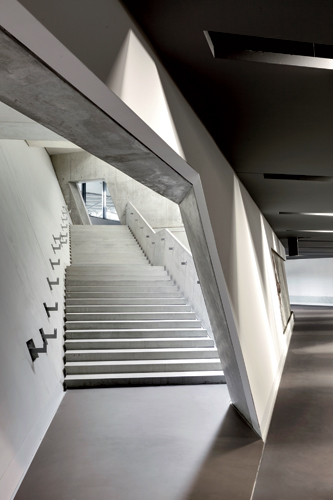Military History Museum
Piercing A Troubled Past: An expansion of a museum of military history in Dresden results in a provocatively symbolic design.




















Architects & Firms
Dresden, Germany
Dresden is a place of ghosts and unease, the site of the most controversial and devastating series of Allied bombing raids of World War II. But today, the city is also a symbol of rebirth and reconciliation, epitomized by the painstaking reconstruction of its historic center—most notably the famous Baroque-style Lutheran church, Frauenkirche, (1726–43), designed with a virtuoso stone dome by George Bähr. A jagged heap of rubble during the Communist East German regime, the church was finally restored at a cost of $240 million in 2005, fifteen years after Germany’s reunification. The city remains a supremely charged territory. And it is here that Daniel Libeskind has just expanded what had been a local East German museum into the largest museum in Germany, with 215,085 square feet of space. It is also now the official central museum of the German Armed Forces.
This simple concept—you could see it as an arrow, a missile, a crashed plane, a knife or sword, the prow of a warship—is an uncharacteristically direct choice of symbolism by Libeskind, who is sometimes inclined to over-intellectualize in his search for form. Consider his 2001 Imperial War Museum in Manchester, England: Its three “shards” were conceived as simplified fragments of a shattered globe that the casual visitor is unlikely to pick up on at a glance. In Dresden, it’s clear enough that the building is sundered by some huge weapon. Libeskind has skillfully handled his angled incision, even to the extent of chopping through existing windows, which are neatly finished around the wedge’s perforated aluminum skin.
The architectural sleight-of-hand is not quite a case of cutting a pie-shaped slice out of the old and then filling in the gap. Rather, the new section is grafted to the old, the steel structure lightly clasping the iron-and-sandstone mother ship with a certain amount of internal reconstruction providing wider-span spaces. The front section—the tip of the arrow—is empty, though it contains an 82-foot-high observation deck within it that looks out over the rebuilt city. The arrow points to the southwest, the direction from which the bombers came in 1945. The bombs destroyed the city in the shape of a wedge with a 40-degree angle at the tip—the same geometry as the Libeskind addition.
At the rear of the building, the twin barbs of the arrowhead are solid beneath the latticework skin to contain gallery space. Inside, angled walls of concrete follow the thrust of the arrow’s path. Within the resulting wedge, dark gray concrete floors and ceilings contrast with the lighter, restored old interior.
The separation of the wedge from the rectangular plan of the existing building is further reinforced by curatorial fiat. While the existing museum presents chronological displays—from 1300 to 1914, 1914 to 1945, and 1945 to today—the new wedge contains thematic exhibitions. They are arranged to include subjects such as military fashion, military toys, technology, and shelter. A freestanding structure at the front of the first floor becomes a mini-Libeskind building in itself and displays exhibits about the horrific effects of war on ordinary people.
The Nazi era, represented in both chronological and thematic displays, is dealt with as dispassionately as the other periods—including the postwar Allied occupation and the emergence of rival armies for East and West Germany. This is far from being a museum that glorifies war or the instruments of death and destruction. The descriptions, presented in both German and English, make clear the cost of conflict.
Libeskind’s design allows for some telling moments: For instance, one full-height space at the rear of the wedge contains a V-2 missile and above it, a Soviet-era Soyuz capsule. The one led to the other, as it did with America’s space program. But in the other full-height rear gallery, rockets and bombs rain down on a series of massive concrete shelters.
The radical difference between the old and new spaces helps distinguish the chronological displays from the themed ones. Yet, as is often the case in Libeskind’s architecture, the geometry leads to some strange leftover spaces that promote a sense of entrapment if you wander into them. Near the top of the museum, where the stairs climb into the bright new spaces, you feel the sense of journey toward... what? Here you arrive at the observation deck with a view over the city. In the gallery behind you is physical evidence of three cities destroyed in World War II: shattered pavements from Dresden and Wielun, Poland; a broken statue from an orphanage in Rotterdam.
This is architecture that is appropriate for its function, combining geometric rigor with clear commentary. While the museum is a streetcar’s ride from the center, it shows a different Dresden apart from the revived, touristic old town. When Libeskind conceived the expansion a decade ago, he was at a creative peak. It shows. In this context, with this weight of history, this military museum is a force for good.
Hugh Pearman is the architecture critic of The Sunday Times of London, and editor of the Journal of the Royal Institute of British Architects.
PeopleOwner: Bundesrepublik Deutschland, Bundeswehr
Architect
Personnel in architect's firm who should receive special credit:
Architect of record:
Associate architect(s):
Interior designer:
Engineer(s): Technical facility equipment: IPRO Dresden
Consultant(s):
Lighting:
Acoustical/ Building Physician:
Fire protection:
Photographer(s):
Renderer(s):
CAD system, project management, or other software used: Gross square footage: 215,085 sq.ft. Cost: $86 million Completion date: October 2011 |
Products
Structural system
Manufacturer of any structural components unique to this project:
Exterior cladding
Curtain wall:
Roofing
Windows
Glazing
Doors
Metal doors:
Wood doors:
Fire-control doors, security grilles:
Upswinging doors, other:
Hardware
Pulls:
Interior finishes
Cabinetwork and custom woodwork:
Paints and stains:
floor and wall tile:
Carpet:
Special interior finishes unique to this project:
Furnishings
Chairs:
Upholstery:
Other furniture:
Lighting
Conveyance
Plumbing |














